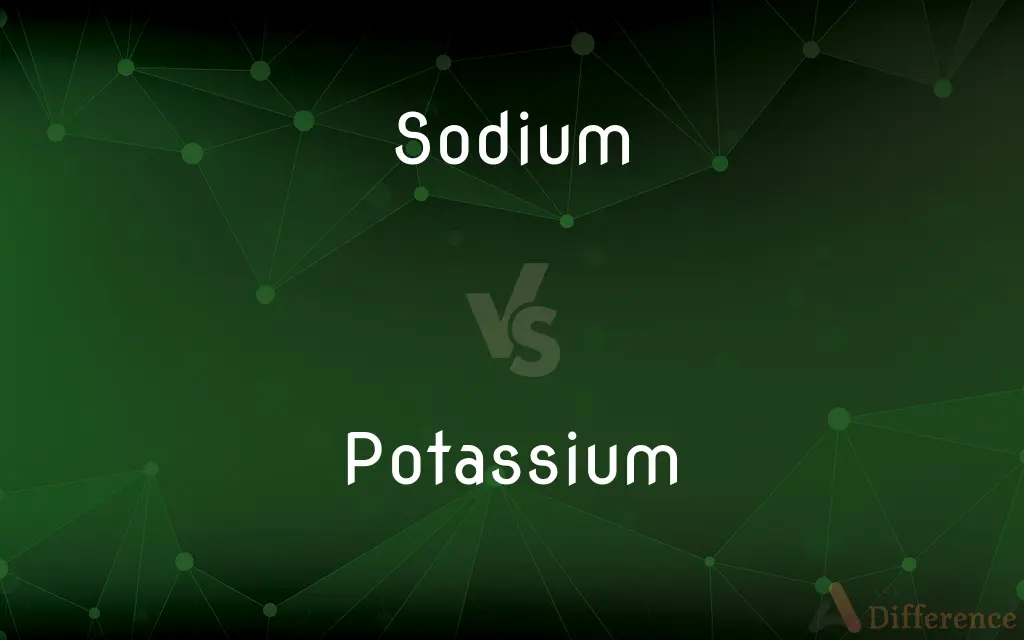Sodium vs. Potassium — What's the Difference?

Difference Between Sodium and Potassium
ADVERTISEMENT
Compare with Definitions
Sodium
Sodium is a chemical element with the symbol Na (from Latin natrium) and atomic number 11. It is a soft, silvery-white, highly reactive metal.
Potassium
Potassium is a chemical element with the symbol K (from Neo-Latin kalium) and atomic number 19. Potassium is a silvery-white metal that is soft enough to be cut with a knife with little force.
Sodium
The chemical element of atomic number 11, a soft silver-white reactive metal of the alkali metal group.
Potassium
A soft, silver-white, extremely reactive element that is an alkali metal, is essential to plant and animal cell functions, and occurs in nature only in compounds. It can be obtained by electrolysis of its hydroxide and is found in, or converted to, a wide variety of salts used especially in fertilizers and soaps. Atomic number 19; atomic weight 39.098; melting point 63.5°C; boiling point 759°C; specific gravity 0.86; valence 1. See Periodic Table.
Sodium
A soft, light, extremely malleable silver-white element that is an alkali metal, reacts violently with water, is naturally abundant in combined forms, especially in common salt, and is used in the production of a wide variety of industrially important compounds. Sodium ions are essential to numerous biological processes in animals. Atomic number 11; atomic weight 22.9898; melting point 97.80°C; boiling point 883°C; specific gravity 0.971 (20°C); valence 1. See Periodic Table.
ADVERTISEMENT
Potassium
A soft, waxy, silvery reactive metal that is never found unbound in nature; an element (symbol K) with an atomic number of 19 and atomic weight of 39.0983. The symbol is derived from the Latin kalium.
Sodium
The chemical element (symbol Na) with an atomic number of 11 and atomic weight of 22.990. It is a soft, waxy, silvery, reactive alkali metal that is never found unbound in nature.
Potassium
(countable) A single atom of this element.
Sodium
Employing sodium.
Potassium
An Alkali element, occurring abundantly but always combined, as in the chloride, sulphate, carbonate, or silicate, in the minerals sylvite, kainite, orthoclase, muscovite, etc. Atomic weight 39.0. Symbol K (Kalium).
Sodium
A common metallic element of the alkali group, in nature always occuring combined, as in common salt, in albite, etc. It is isolated as a soft, waxy, white, unstable metal, so highly reactive that it combines violently with water, and to be preserved must be kept under petroleum or some similar liquid. Sodium is used combined in many salts, in the free state as a reducer, and as a means of obtaining other metals (as magnesium and aluminium) is an important commercial product. Symbol Na (Natrium). Atomic weight 22.990. Specific gravity 0.97.
Potassium
A light soft silver-white metallic element of the alkali metal group; oxidizes rapidly in air and reacts violently with water; is abundant in nature in combined forms occurring in sea water and in carnallite and kainite and sylvite
Sodium
A silvery soft waxy metallic element of the alkali metal group; occurs abundantly in natural compounds (especially in salt water); burns with a yellow flame and reacts violently in water; occurs in sea water and in the mineral halite (rock salt)
Share Your Discovery

Previous Comparison
Baseband vs. Broadband
Next Comparison
Tachi vs. Katana













































